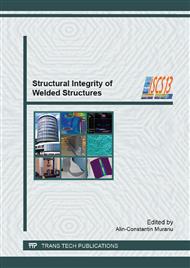[1]
Cornell CN, Osteoconductive materials and their role as substitutes for autogenous bone grafts, Ortho. Clin. North Am. 30 (1999) 591-598.
DOI: 10.1016/s0030-5898(05)70112-7
Google Scholar
[2]
Y.M. Kong, S. Kim, H.E. Kim, Reinforcement of hydroxyapatite bioceramics by addition of ZrO2 coated with Al2O3, J. Am. Ceram. Soc. 82 (1999) 2963-2968.
DOI: 10.1111/j.1151-2916.1999.tb02189.x
Google Scholar
[3]
T. Ioanovici, F. Monchau, Ph. Hivart, B. Genestie, L.Bereteu, H.F. Hildebrand, "Evaluation of a dense calcite ceramic as bone substitute" 24th European Conference Biomaterials ESB (2011), 240-244.
Google Scholar
[4]
T.J. Webster, E.A. Massa-Schlueter, J.L. Smith, E.B. Slamovich, Osteoblast response to hydroxyapatite doped with divalent and trivalent cations, Biomaterials 25 (2004) 2111–2121.
DOI: 10.1016/j.biomaterials.2003.09.001
Google Scholar
[5]
S. Kannan, S.I. Vieira, S.M. Olhero, P.M.C. Torres, S. Pina, O.A.B. da Cruz e Silva, J.M.F. Ferreira, Synthesis, mechanical and biological characterization of ionic doped carbonated hydroxyapatite/β-tricalcium phosphate mixtures, Acta Biomaterialia 7 (2011) 1835–1843.
DOI: 10.1016/j.actbio.2010.12.009
Google Scholar
[6]
T. Ioanovici, F. Monchau, K. Berdich, Ph. Hivart, M. Traisnel, L. Bereteu "Influence of magnesium doping on synthesized hidroxyapatite using the wet precipitation method" 3rd International Conference on e-Health and Bioengineering EHB (2011), 1-4.
Google Scholar
[7]
E. Damien, P.A. Revell, Enhancement of the Bioactivity of Orthopaedic Biomaterials: Role of Growth Factors, Ion Substitution and Implant Architecture in: A. Nather, Bone Grafts And Bone Substitutes, Basic Science and Clinical Applications, World Scientific Publishing Co. Pte. Ltd., Singapore, 2005, p.481.
DOI: 10.1142/9789812775337_0029
Google Scholar
[8]
K.A. Khalil, S.W Kim, N. Dharmaraj, K.W. Kim, H.Y. Kim, Novel mechanism to improve toughness of the hydroxyapatite bioceramics using high-frequency induction heat sintering, J. Mater. Proc. Technol. 187-188 (2007) 417-420.
DOI: 10.1016/j.jmatprotec.2006.11.105
Google Scholar
[9]
A.J. Ruys, M. Wei C.C. Sorrell M.R. Dickson, A. Brandwood, B.K. Milthorpe, Sintering effect on the strength of hydroxyapatite, Biomaterials 16 (1995) 409-415.
DOI: 10.1016/0142-9612(95)98859-c
Google Scholar
[10]
A. Oyane, H.M. Kim, T. Furuya, T. Kokubo, T. Miyazaki, T. Nakamura, Preparation and assessment of revised simulated body fluids, J Biomed Mater Res A 65 (2003) 188–195.
DOI: 10.1002/jbm.a.10482
Google Scholar
[11]
Harry F. Olson, Elements of Acoustical Engineering, D.Van Nostrand Company, Inc. London, 1955.
Google Scholar
[12]
Information on http://seis.geus.net/software/seisan/n
Google Scholar
[13]
Jimin He, Zhi-Fang Fu, Modal Analysis, Butterworth-Heinemann, Oxford Auckland Boston Johannesburg Melbourne New Delhi, (2001)
Google Scholar
[14]
Gh. Buzdugan, E. Mihailescu, M. Rades, Vibrations Mesurement
Google Scholar
[15]
Oleg Prokopiev, Igor Sevostianov, Dependence of Mechanical Properies of Sintered Hydroxiapatite on Sintering Temperature, Materials Sci. and Engineering, A 431.1 (2006): 218-227
DOI: 10.1016/j.msea.2006.05.158
Google Scholar
[16]
S.W. Park and Y.R. Kim, Fitting Prony-series viscoelastic models with power–law presmoothing, J. of Mat. in Civil Engng. 31(2001) 1-6.
DOI: 10.1061/(asce)0899-1561(2001)13:1(26)
Google Scholar


